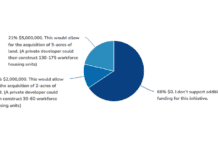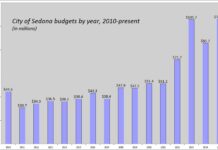Residents who want to participate in the city of Sedona’s budget process should schedule time for three five-hour meetings during the first two weeks of May.
By sitting through the series of scheduled workshops where the city staff and City Council grind through hundreds of line items and dozens of decision tables, participants can gain a thorough appreciation of the degree of detail involved in the process.
The workshops begin Monday, May 5, from 9 a.m. to 2 p.m. in the Vultee Conference Room at the city complex at 106 Roadrunner Drive. Two more will take place on Monday, May 12, and Wednesday, May 14, from 9 a.m. to 2 p.m. in the Vultee Conference Room.
By Susan Johnson
Larson Newspapers
Residents who want to participate in the city of Sedona’s budget process should schedule time for three five-hour meetings during the first two weeks of May.
By sitting through the series of scheduled workshops where the city staff and City Council grind through hundreds of line items and dozens of decision tables, participants can gain a thorough appreciation of the degree of detail involved in the process.
The workshops begin Monday, May 5, from 9 a.m. to 2 p.m. in the Vultee Conference Room at the city complex at 106 Roadrunner Drive. Two more will take place on Monday, May 12, and Wednesday, May 14, from 9 a.m. to 2 p.m. in the Vultee Conference Room.
Sedona’s budget is divided into two major parts.
One part comprises the general fund and goes to pay everyday expenses related to wages, public works, general services, parks and recreation and other similar items.
Preliminary figures for the general fund total a little more than $13 million.
The second part is by far the larger, the majority related to wastewater, capital improvements and streets, with early estimates at $41.5 million.
Both funds together come to $54.6 million, a reduction of approximately 10 percent compared with the prior year’s budget.
Much of the money now dedicated to wastewater was mandated years ago through a consent decree levied by the Arizona Department of Environmental Quality after the city experienced a large sewage spill in the late 1980s.
The newly incorporated city was forced to take out millions of dollars in debt to upgrade poor infrastructure inherited from the county, effectively committing Sedona to onerous loans for decades to come.
Despite this burden, the city’s finances are strong, running a surplus of revenues over expenditures in the general fund for the past four years and once again ahead of expenditures in the first six months of this year.
City Manager Eric Levitt generally applies “worst-case scenarios” to both revenues and expenditures.
As a result, the budget as it is prepared on paper sometimes shows a deficit in revenues, however, the reality is that
expenditures have historically come in below income.
To prevent any year-end surprises, in his budget memo to City Council, Levitt proposed conducting a mid-year review of capital projects and overall financial status.
The biggest single piece of the revenues that pay for combined city operations comes from sales and bed taxes which are estimated to bring in a little more than $19 million in 2009.
This amount has been
calculated using a 10 percent decrease over prior years’ actuals in addition to being extrapolated using the current year’s collections as a base.
Additional moneys are gleaned from licenses and permits, grants, donations and intergovernmental agreements, service charges and various rental fees, all of which are forecast to equal $11.5 million.
Proceeds from bonds in the amount of $10.3 million plus a reserve account of $13.7 million brings the total to $54.6 million.
Decision worksheets are used by the city staff to evaluate the need for new and ongoing programs provided by the city.
Questions used on the worksheets are straight-forward, asking whether the program or issue affects the quality of life of residents, if it’s typically a government function and if it relates to strategic and community plans.
In addition, the history and background of the program is provided along with a risk analysis, list of resources required, implementation time frame and proposed expenditures.
Levitt said he isn’t a fan of cutting programs and services, but if reductions are necessary he looks at each program individually.
“[I prefer] to cut entire programs rather than all programs by a certain percentage in order to maintain levels of quality in the remaining programs and services,” Levitt said.
The city’s preliminary budget documents are posted online at www.sedonaaz.gov.
Susan Johnson can be reached at
282-7795, Ext. 129 or e-mail
sjohnson@larsonnewspapers.com





















